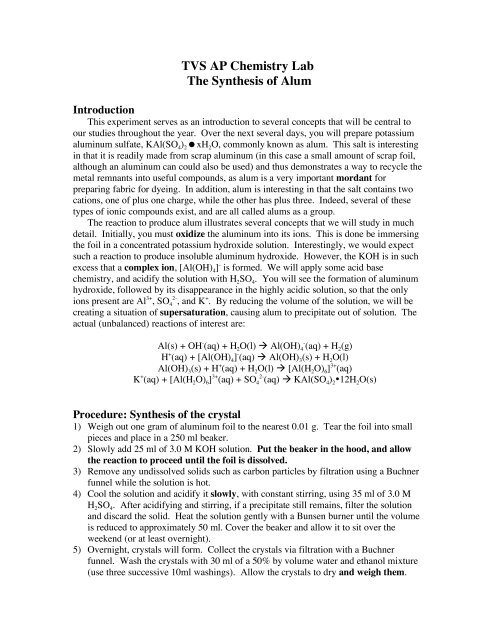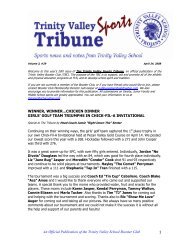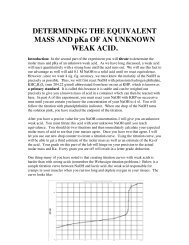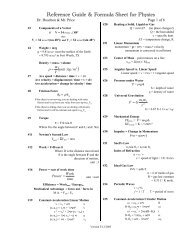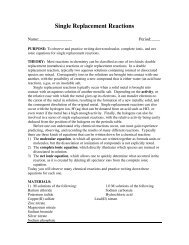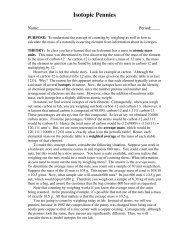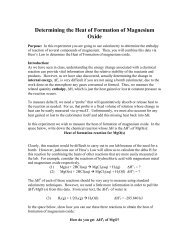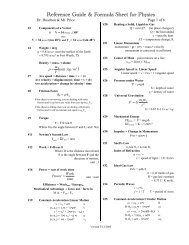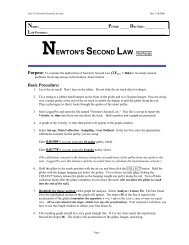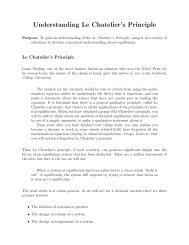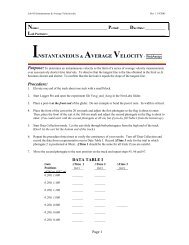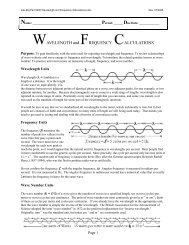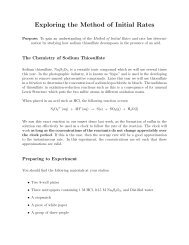TVS AP Chemistry Lab The Synthesis of Alum
TVS AP Chemistry Lab The Synthesis of Alum
TVS AP Chemistry Lab The Synthesis of Alum
You also want an ePaper? Increase the reach of your titles
YUMPU automatically turns print PDFs into web optimized ePapers that Google loves.
<strong>TVS</strong> <strong>AP</strong> <strong>Chemistry</strong> <strong>Lab</strong><strong>The</strong> <strong>Synthesis</strong> <strong>of</strong> <strong>Alum</strong>IntroductionThis experiment serves as an introduction to several concepts that will be central toour studies throughout the year. Over the next several days, you will prepare potassiumaluminum sulfate, KAl(SO 4 ) 2 xH 2 O, commonly known as alum. This salt is interestingin that it is readily made from scrap aluminum (in this case a small amount <strong>of</strong> scrap foil,although an aluminum can could also be used) and thus demonstrates a way to recycle themetal remnants into useful compounds, as alum is a very important mordant forpreparing fabric for dyeing. In addition, alum is interesting in that the salt contains twocations, one <strong>of</strong> plus one charge, while the other has plus three. Indeed, several <strong>of</strong> thesetypes <strong>of</strong> ionic compounds exist, and are all called alums as a group.<strong>The</strong> reaction to produce alum illustrates several concepts that we will study in muchdetail. Initially, you must oxidize the aluminum into its ions. This is done be immersingthe foil in a concentrated potassium hydroxide solution. Interestingly, we would expectsuch a reaction to produce insoluble aluminum hydroxide. However, the KOH is in suchexcess that a complex ion, [Al(OH) 4 ] - is formed. We will apply some acid basechemistry, and acidify the solution with H 2 SO 4 . You will see the formation <strong>of</strong> aluminumhydroxide, followed by its disappearance in the highly acidic solution, so that the onlyions present are Al 3+ , SO 42-, and K + . By reducing the volume <strong>of</strong> the solution, we will becreating a situation <strong>of</strong> supersaturation, causing alum to precipitate out <strong>of</strong> solution. <strong>The</strong>actual (unbalanced) reactions <strong>of</strong> interest are:Al(s) + OH - (aq) + H 2 O(l) Al(OH) 4 - (aq) + H 2 (g)H + (aq) + [Al(OH) 4 ] - (aq) Al(OH) 3 (s) + H 2 O(l)Al(OH) 3 (s) + H + (aq) + H 2 O(l) [Al(H 2 O) 6 ] 3+ (aq)K + (aq) + [Al(H 2 O) 6 ] 3+ (aq) + SO 42-(aq) KAl(SO 4 ) 2 •12H 2 O(s)Procedure: <strong>Synthesis</strong> <strong>of</strong> the crystal1) Weigh out one gram <strong>of</strong> aluminum foil to the nearest 0.01 g. Tear the foil into smallpieces and place in a 250 ml beaker.2) Slowly add 25 ml <strong>of</strong> 3.0 M KOH solution. Put the beaker in the hood, and allowthe reaction to proceed until the foil is dissolved.3) Remove any undissolved solids such as carbon particles by filtration using a Buchnerfunnel while the solution is hot.4) Cool the solution and acidify it slowly, with constant stirring, using 35 ml <strong>of</strong> 3.0 MH 2 SO 4 . After acidifying and stirring, if a precipitate still remains, filter the solutionand discard the solid. Heat the solution gently with a Bunsen burner until the volumeis reduced to approximately 50 ml. Cover the beaker and allow it to sit over theweekend (or at least overnight).5) Overnight, crystals will form. Collect the crystals via filtration with a Buchnerfunnel. Wash the crystals with 30 ml <strong>of</strong> a 50% by volume water and ethanol mixture(use three successive 10ml washings). Allow the crystals to dry and weigh them.
Calculations:1) <strong>The</strong> formula for the alum is KAl(SO 4 ) 2 •12H 2 O. <strong>The</strong> aluminum in your reaction wasthe limiting reactant, so use this information to calculate the percent yield <strong>of</strong> yourcrystals.Discussion:You should discuss two main concepts in your discussion section:First, explain in your discussion section be how you were able to precipitate out thealum from aqueous solution, even though it is water-soluble. Be sure to include adiscussion <strong>of</strong> the terms unsaturated, saturated, and supersaturated in yourexplanation. Explain. Finally, you want to discuss why your percent yield cannot be100% (for experimental reasons). All <strong>of</strong> this should <strong>of</strong> course be in a well writtenparagraph or paragraphs, using transitions as the READER HAS NO IDEA WHATQUESTIONS YOU ARE ANSWERING!Conclusion: One sentence stating what you have made and its percent yield.Thus, to summarize, this write-up has no intro, just title, purpose, procedure,observations, data, calculations discussion and conclusion.


